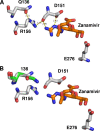Zanamivir-resistant influenza viruses with a novel neuraminidase mutation
- PMID: 19641000
- PMCID: PMC2753113
- DOI: 10.1128/JVI.01200-09
Zanamivir-resistant influenza viruses with a novel neuraminidase mutation
Abstract
The neuraminidase inhibitors zanamivir and oseltamivir are marketed for the treatment and prophylaxis of influenza and have been stockpiled by many countries for use in a pandemic. Although recent surveillance has identified a striking increase in the frequency of oseltamivir-resistant seasonal influenza A (H1N1) viruses in Europe, the United States, Oceania, and South Africa, to date there have been no reports of significant zanamivir resistance among influenza A (H1N1) viruses or any other human influenza viruses. We investigated the frequency of oseltamivir and zanamivir resistance in circulating seasonal influenza A (H1N1) viruses in Australasia and Southeast Asia. Analysis of 391 influenza A (H1N1) viruses isolated between 2006 and early 2008 from Australasia and Southeast Asia revealed nine viruses (2.3%) that demonstrated markedly reduced zanamivir susceptibility and contained a previously undescribed Gln136Lys (Q136K) neuraminidase mutation. The mutation had no effect on oseltamivir susceptibility but caused approximately a 300-fold and a 70-fold reduction in zanamivir and peramivir susceptibility, respectively. The role of the Q136K mutation in conferring zanamivir resistance was confirmed using reverse genetics. Interestingly, the mutation was not detected in the primary clinical specimens from which these mutant isolates were grown, suggesting that the resistant viruses either occurred in very low proportions in the primary clinical specimens or arose during MDCK cell culture passage. Compared to susceptible influenza A (H1N1) viruses, the Q136K mutant strains displayed greater viral fitness than the wild-type virus in MDCK cells but equivalent infectivity and transmissibility in a ferret model.
Figures



Similar articles
-
Emergence and spread of oseltamivir-resistant A(H1N1) influenza viruses in Oceania, South East Asia and South Africa.Antiviral Res. 2009 Jul;83(1):90-3. doi: 10.1016/j.antiviral.2009.03.003. Epub 2009 Mar 24. Antiviral Res. 2009. PMID: 19501261
-
Impact of mutations at residue I223 of the neuraminidase protein on the resistance profile, replication level, and virulence of the 2009 pandemic influenza virus.Antimicrob Agents Chemother. 2012 Mar;56(3):1208-14. doi: 10.1128/AAC.05994-11. Epub 2011 Dec 27. Antimicrob Agents Chemother. 2012. PMID: 22203589 Free PMC article.
-
Host cell selection of influenza neuraminidase variants: implications for drug resistance monitoring in A(H1N1) viruses.Antiviral Res. 2010 Feb;85(2):381-8. doi: 10.1016/j.antiviral.2009.11.005. Epub 2009 Nov 13. Antiviral Res. 2010. PMID: 19917319
-
Influenza neuraminidase inhibitors: antiviral action and mechanisms of resistance.Influenza Other Respir Viruses. 2013 Jan;7 Suppl 1(Suppl 1):25-36. doi: 10.1111/irv.12047. Influenza Other Respir Viruses. 2013. PMID: 23279894 Free PMC article. Review.
-
Emergence of oseltamivir resistance: control and management of influenza before, during and after the pandemic.Infect Disord Drug Targets. 2013 Feb;13(1):34-45. doi: 10.2174/18715265112129990006. Infect Disord Drug Targets. 2013. PMID: 23675925 Review.
Cited by
-
Antivirals Targeting the Surface Glycoproteins of Influenza Virus: Mechanisms of Action and Resistance.Viruses. 2021 Apr 6;13(4):624. doi: 10.3390/v13040624. Viruses. 2021. PMID: 33917376 Free PMC article. Review.
-
High-Efficiency Capture of Drug Resistant-Influenza Virus by Live Imaging of Sialidase Activity.PLoS One. 2016 May 27;11(5):e0156400. doi: 10.1371/journal.pone.0156400. eCollection 2016. PLoS One. 2016. PMID: 27232333 Free PMC article.
-
Anti-high mobility group box-1 monoclonal antibody treatment provides protection against influenza A virus (H1N1)-induced pneumonia in mice.Crit Care. 2015 Jun 11;19(1):249. doi: 10.1186/s13054-015-0983-9. Crit Care. 2015. PMID: 26067826 Free PMC article.
-
Alloferon and Zanamivir Show Effective Antiviral Activity against Influenza A Virus (H1N1) Infection In Vitro and In Vivo.Int J Mol Sci. 2022 Dec 30;24(1):678. doi: 10.3390/ijms24010678. Int J Mol Sci. 2022. PMID: 36614125 Free PMC article.
-
Detection of molecular markers of drug resistance in 2009 pandemic influenza A (H1N1) viruses by pyrosequencing.Antimicrob Agents Chemother. 2010 Mar;54(3):1102-10. doi: 10.1128/AAC.01417-09. Epub 2009 Dec 22. Antimicrob Agents Chemother. 2010. PMID: 20028826 Free PMC article.
References
-
- Davies, W. L., R. R. Grunert, R. F. Haff, J. W. McGahen, E. M. Neumayer, M. Paulshock, J. C. Watts, T. R. Wood, E. C. Hermann, and C. E. Hoffmann. 1964. Antiviral activity of 1-adamantanamine (Amantadine). Science 144:862-863. - PubMed
-
- de Jong, M. D., T. T. Tran, H. K. Truong, M. H. Vo, G. J. Smith, V. C. Nguyen, V. C. Bach, T. Q. Phan, Q. H. Do, Y. Guan, J. S. Peiris, T. H. Tran, and J. Farrar. 2005. Oseltamivir resistance during treatment of influenza A (H5N1) infection. N. Engl. J. Med. 353:2667-2672. - PubMed
-
- Dharan, N. J., L. V. Gubareva, J. J. Meyer, M. Okomo-Adhiambo, R. C. McClinton, S. A. Marshall, G. K. St, S. Epperson, L. Brammer, A. I. Klimov, J. S. Bresee, and A. M. Fry. 2009. Infections with oseltamivir-resistant influenza A(H1N1) virus in the United States. JAMA 301:1034-1041. - PubMed
-
- Fuyuno, I. 2007. Tamiflu side effects come under scrutiny. Nature 446:358-359. - PubMed
Publication types
MeSH terms
Substances
LinkOut - more resources
Full Text Sources
Other Literature Sources

